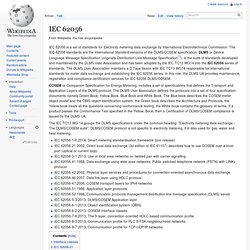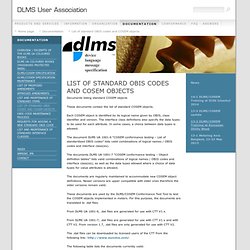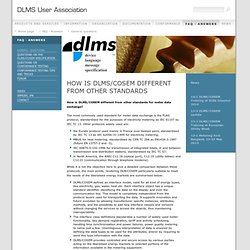DLMS documentation
> Juanlugm
> DLMS/COSEM
Connection-oriented communication. Connection-oriented (CO-mode[1]) communication is a network communication mode in telecommunications and computer networking, where a communication session or a semi-permanent connection is established before any useful data can be transferred, and where a stream of data is delivered in the same order as it was sent.

The alternative to connection-oriented transmission is connectionless communication, for example the datagram mode communication used by the IP and UDP protocols, where data may be delivered out of order, since different packets are routed independently, and may be delivered over different paths. Connection-oriented communication may be a circuit switched connection, or a packet-mode virtual circuit connection. Circuit switching[edit] Circuit switched communication, for example the public switched telephone network, ISDN, SONET/SDH and optical mesh networks, are intrinsically connection-oriented communications systems.
Virtual circuit switching[edit] Examples[edit]
Connection-oriented protocol. IEC 62056. IEC 62056 is a set of standards for Electricity metering data exchange by International Electrotechnical Commission.

The IEC 62056 standards are the International Standard versions of the DLMS/COSEM specification. DLMS or Device Language Message Specification (originally Distribution Line Message Specification[1]), is the suite of standards developed and maintained by the DLMS User Association and has been adopted by the IEC TC13 WG14 into the IEC 62056 series of standards. The DLMS User Association maintains a D Type liaison with IEC TC13 WG14 responsible for international standards for meter data exchange and establishing the IEC 62056 series. In this role, the DLMS UA provides maintenance, registration and compliance certification services for IEC 62056 DLMS/COSEM. COSEM or Companion Specification for Energy Metering, includes a set of specifications that defines the Transport and Application Layers of the DLMS protocol. Interface classes[edit]
DLMS doc. List of standard OBIS codes and COSEM objects. Documents listing standard COSEM objects These documents contain the list of standard COSEM objects.

Each COSEM object is identified by its logical name given by OBIS, class identifier and version. The interface class definitions also specify the data types to be used for each attribute. In some cases, a choice between data types is allowed. The document DLMS UA 1001-6 “COSEM conformance testing – List of standardised OBIS codes” lists valid combinations of logical names / OBIS codes and interface class(es). The documents DLMS UA 1001-7 “COSEM conformance testing – Object definition tables” lists valid combinations of logical names / OBIS codes and interface class(es), as well as the data types allowed where a choice of data types for value attributes is allowed.
The documents are regularly maintained to accommodate new COSEM object definitions. These documents are used by the DLMS/COSEM Conformance Test Tool to test the COSEM objects implemented in meters.
DLMS/COSEM components. How is DLMS/COSEM different from other standards. How is DLMS/COSEM different from other standards for meter data exchange?

The most commonly used standard for meter data exchange is the FLAG protocol, standardised for the purposes of electricity metering as IEC 61107 by IEC TC 13. Other protocols widely used are: the Euridis protocol used mainly in France over twisted pairs, standardised by IEC TC 13 as IEC 62056-31:1999 for electricity metering; MBUS for heat metering, standardised by CEN TC 294 as EN1434-3:1997 (future EN 13757-2 and -3), IEC 60870-5-102:1996 for transmission of integrated totals, in and between transmission and distribution stations, standardised by IEC TC 57; in North America, the ANSI C12.18 (optical port), C12.19 (utility tables) and C12.21 (communication through telephone modems).
While it is not the objective here to give a detailed comparison between these protocols, the main points, rendering DLM/COSEM particularly suitable to meet the needs of the liberalised energy markets are summarised below:




